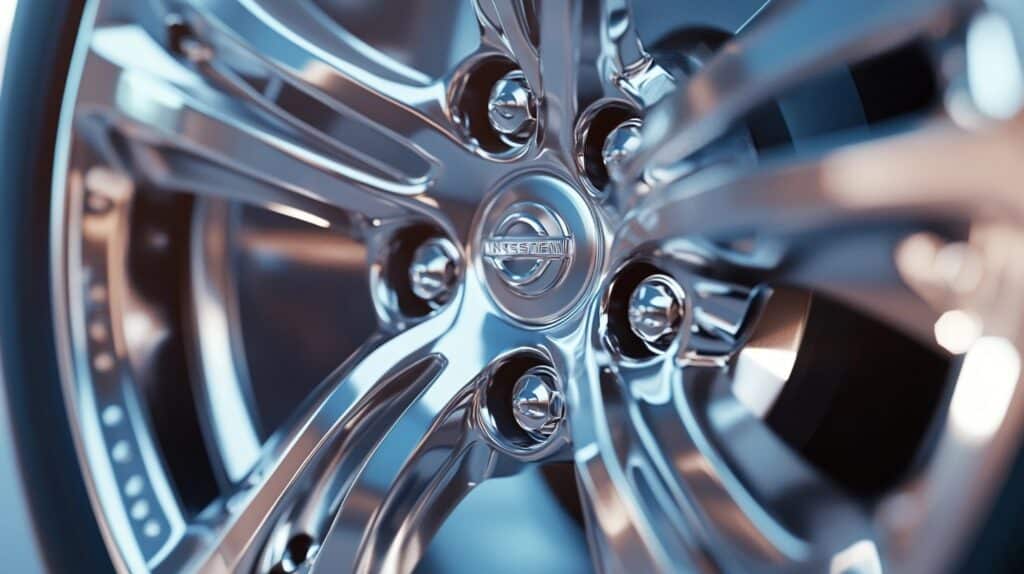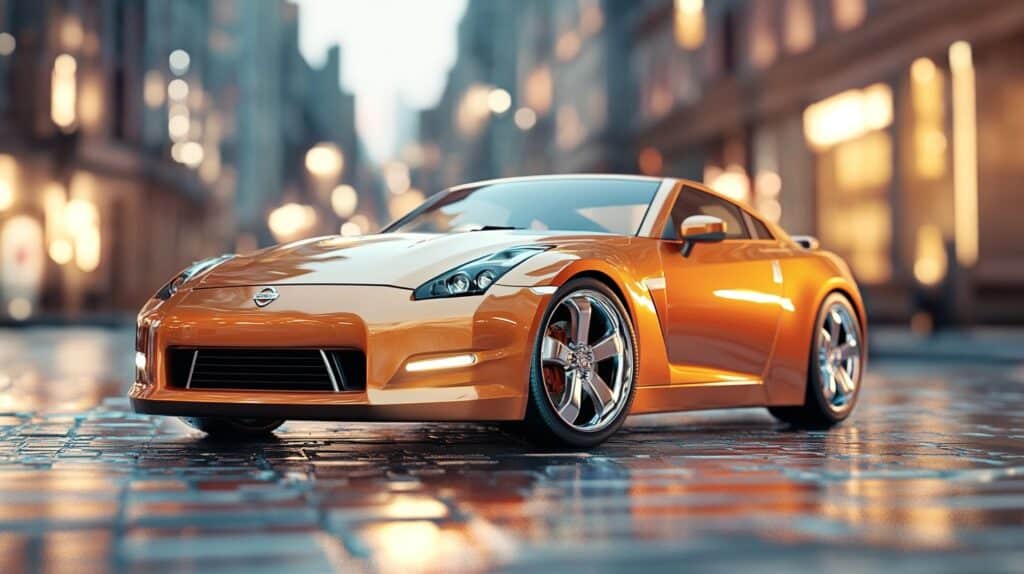Picking the right wheels for your Nissan can be tricky, especially when it comes to understanding bolt patterns.
Many car owners struggle with this, often discovering too late that their new wheels don’t fit their vehicle. We’ll make this simple for you.
In this guide, you’ll learn everything you need to know about Nissan bolt patterns, using clear, easy-to-understand terms. No complex jargon, just practical information.
You’ll discover how to identify your Nissan’s bolt pattern, the standard patterns for different Nissan models, what to check before buying new wheels, and how to avoid common fitment issues.
What is the Bolt Pattern for a Nissan?
A bolt pattern is simply the way lug holes are arranged on your wheel. Think of it as a circle where the lug nuts attach your wheel to the car. The bolt pattern uses two numbers to tell you everything you need to know.
For example, in “5×114.3”, the first number “5” tells you there are five lug holes, while “114.3” indicates the diameter of the circle (in millimeters) on which these holes are placed.
Some measurements might be listed in inches – for instance, 4.5 inches is the same as 114.3mm.
Understanding your vehicle’s bolt pattern is crucial for safety. When you buy new wheels, the bolt pattern must match exactly – there’s no room for “close enough.”
An incorrect pattern can lead to poor wheel fit, vibration issues, and unsafe driving conditions.
Understanding Nissan Bolt Patterns and Their Compatibility

Nissan uses three standard bolt patterns across their vehicle lineup. Smaller and older models typically use a 4×114.3mm pattern.
Most Nissan sedans and hatchbacks, including the Altima, Maxima, and Sentra, use a 5×114.3mm pattern. For larger vehicles such as the Titan and Armada, Nissan opts for a 6×139.7mm pattern.
Some Nissan models have seen changes in their bolt patterns over different generations. The Sentra is a perfect example – while newer models feature a 5×114.3mm pattern, older generations came with a 4×114.3mm setup.
This is why it’s essential to verify your specific model’s bolt pattern by year, as a wheel that fits a 2020 Sentra might not be compatible with a 2000 model, despite being the same nameplate.
This attention to detail saves both time and money when purchasing new wheels.
List of the Correct Bolt Pattern for Different Nissan Models
| Category | Models | Bolt Pattern |
|---|---|---|
| Sedans and Hatchbacks | Altima, Maxima, Leaf | 5×114.3mm |
| Sentra (Older Models) | 4×114.3mm | |
| Sentra (Newer Models) | 5×114.3mm | |
| SUVs and Trucks | Armada, Titan | 6×139.7mm |
| Rogue, Pathfinder | 5×114.3mm | |
| Frontier (Older Models) | 6×139.7mm | |
| Frontier (Newer Models) | 6×114.3mm | |
| Xterra | 6×114.3mm | |
| Sports Cars | 370Z, GT-R | 5×114.3mm |
| Specialty Vehicles | NV Cargo, NV Passenger (1500/2500/3500) | 8x165mm |
How to Identify the Correct Bolt Pattern for a Specific Nissan Model

Finding the right bolt pattern for your Nissan doesn’t have to be complicated. Here’s a straightforward guide to help you measure and verify your vehicle’s bolt pattern:
Step 1: Count the lug holes on your wheel hub. Nissan vehicles typically have either 4, 5, or 6 lugs, depending on the model.
Step 2: Measure the bolt circle diameter (PCD) using this method:
- For 4 or 6 lugs: Measure from the center of one lug hole to the center of the opposite hole
- For 5 lugs: Measure from the center of any lug hole to the outer edge where an imaginary circle would pass through the center of the farthest lug
Step 3: Check your measurements against your vehicle’s manual specifications to confirm accuracy.
Step 4: If you’re unsure about your measurements, have a professional wheel specialist verify them.
Essential Tools for Measurement:
| Tool | Purpose | Recommended For |
|---|---|---|
| Tape Measure | Basic measurements | DIY measurement |
| Bolt Pattern Gauge | Precise measurements | More accurate results |
| Digital Caliper | Detailed measurements | Professional use |
| Wheel Fitment Guide | Reference checking | Verification |
Important Tips:
- Always verify measurements twice before making a purchase
- Consider that older Nissans might have different patterns than newer models
- Remember that some aftermarket wheels might have been installed, so don’t assume the current wheels show the original pattern
- Be careful with multi-fit wheels – while they offer flexibility, ensure they’re properly compatible with your vehicle
Comparisons Between Nissan’s and Other Brands’ Bolt Patterns with Prices

| Brand | Common Bolt Pattern | Models | Price Range for Wheels (Per Set) |
|---|---|---|---|
| Nissan | 5×114.3mm | Altima, Maxima, Rogue, Pathfinder | $200 – $600 |
| 6×139.7mm | Titan, Armada | $300 – $800 | |
| Honda | 5×114.3mm | Accord, CR-V, Pilot | $250 – $650 |
| 4x100mm | Civic, Fit | $200 – $500 | |
| Toyota | 5×114.3mm | Camry, RAV4 | $250 – $700 |
| 6×139.7mm | Tacoma, Tundra | $350 – $850 | |
| Ford | 5×114.3mm | Fusion, Escape | $250 – $700 |
| 6x135mm | F-150, Expedition | $400 – $900 | |
| Chevrolet | 5x120mm | Malibu, Traverse | $300 – $700 |
| 6×139.7mm | Silverado, Tahoe | $400 – $1,000 |
How to Maintain Bolt Patterns on Your Nissan

Taking care of your Nissan’s wheel mounting system helps ensure safe driving and extends the life of your wheels.
Here’s what you need to know about proper maintenance:
1. Regular Inspection
Check your lug nuts and bolts monthly for signs of wear. Look for rust, stripped threads, or damage that might affect wheel security.
Loose lug nuts can lead to wheel wobble or, worse, wheel separation. Make this check part of your routine maintenance, especially after long trips or rough road conditions.
2. Proper Cleaning Methods
Keep your wheel hubs and lug nuts clean to prevent corrosion.
Use a wire brush to remove any rust buildup, and apply a thin coat of anti-seize compound on the threads – but never on the lug nut seats. This makes future wheel removal easier while maintaining proper torque.
3. Correct Tightening Methods
Follow your Nissan’s recommended torque specifications when tightening lug nuts. Most Nissan models require between 80 to 100 foot pounds of torque.
Always use a torque wrench and tighten in a star pattern for even pressure distribution. Too much torque can stretch the studs, while too little might let wheels loosen over time.
4. Hub Ring Usage
If your aftermarket wheels have a larger center bore than your Nissan’s hub, use the correct size hub rings.
These rings center the wheel properly on the hub, preventing vibration and ensuring even weight distribution. Always check that hub rings are properly seated before mounting wheels.
Conclusion
Understanding your Nissan’s bolt pattern is crucial for safe wheel fitment and optimal performance.
While it might seem technical at first, knowing your vehicle’s specific pattern saves time, money, and prevents potential safety issues down the road.
Remember to always verify your specific model’s bolt pattern before purchasing new wheels, as patterns can vary between different years of the same model.
When in doubt, consult a professional wheel specialist or your local Nissan dealer.
Ready to start looking for new wheels? Keep this guide handy, and don’t forget to:
- Check your specific model and year
- Measure twice before purchasing
- Follow proper maintenance procedures
- Use the right tools for installation
Need more help? Your local Nissan service center can assist with any wheel fitment questions.
Frequently Asked Questions
What Is the Bolt Pattern on A Nissan Altima?
Nissan Altima, since 2002, used a 5×114.3 bolt pattern. Older models before 2002 came with a 4×114.3 pattern.
Is 5×4.5 and 5×114.3 the Same Bolt Pattern?
Yes, 5×4.5 and 5×114.3 are exactly the same bolt pattern, just measured in different units – inches versus millimeters.
What Wheels Fit a Nissan Rogue?
Nissan Rogue wheels come in 17 to 19-inch sizes, with a 5×114.3 bolt pattern. Check your specific model year for exact size compatibility.
Will a 5×114.3 Fit a 5×120 Bolt Pattern?
No, these patterns aren’t directly compatible. You’ll need wheel adapters to fit 5×114.3 wheels on a 5×120 hub.


